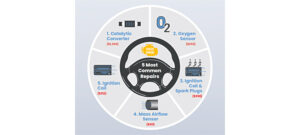The other four major groups of DIFM outlets suffered lower product sales over the past five years
Fort Wayne, Ind.—Three groups of repair outlets generated all Do-It-For-Me (DIFM) car and light truck product growth over the past five years (2016 to 2021), according to a new analysis. “Repair Specialists” made the largest contribution to DIFM product growth, followed by “Foreign Specialists” and “Vehicle Dealers.” The other four major groups of DIFM outlets suffered lower product sales over these five years.
“This reflects the dramatic impact of the pandemic on the population of repair outlets in the U.S., the shifting nameplate mix and age profile of vehicles in operation (VIO), and changes in the competitive positioning of major groups of repair outlets,” stated the latest Lang Aftermarket iReport released this week.
“The concentration of product sales growth has changed the strength of repair product brands, shifted the sales share of distribution channels, and increased growth of online auto repair purchases and o2o transactions in the DIFM market.”
Here’s a breakdown of the report and major takeaways.
Major DIFM Outlet Groups
Lang Marketing tracks the Do-It-For-Me (DIFM) product sales of seven major groups of repair outlets: Service Stations & Garages, Repair Specialists, Foreign Specialists, Tire Stores, Auto Parts Stores with bays, Discount Stores/Mass Merchandisers, and Vehicle Dealers.
Over the past five years (2016 to 2021) the performances of these outlet groups have changed, as the pandemic altered their population mix and the country’s VIO underwent significant changes in its nameplate mix and age profile.
45,000 Fewer Service Bays
At mid-year 2021, there were approximately 45,000 fewer light vehicle service bays nationwide than five years earlier. This bay reduction ran contrary to the rise of vehicles in operation (VIO).
As the number of light vehicle service bays in the U.S. fell between 2016 and 2021, the VIO increased by nearly 7%, and DIFM product and labor sales climbed by more than 10%, at user-price.
Top Three DIFM Performers
DIFM product sales growth for cars and light trucks has concentrated, with three outlet groups generating all DIFM product sales expansion between 2016 and 2021: Repair Specialists, Foreign Specialists, and Vehicle Dealers.
Specialty Outlets
There are two types of light vehicle specialty outlets: Repair Specialists (outlets with a limited array of service jobs) and Foreign Specialists (outlets focused on foreign nameplate vehicle repair).
More than 70% of DIFM market product expansion was generated by these two groups of repair outlets between 2016 and 2021. Repair Specialists were responsible for more than 40% of market expansion, and Foreign Specialists generated 30% of market growth.
Other DIFM Growth Contributors
Vehicle Dealers were the only other contributors to DIFM product growth between 2016 and 2021. They were responsible for 29% of the $5 billion increase in light vehicle product volume at user-price.
Other Repair Outlets
Four groups of repair outlets failed to achieve aftermarket product growth between 2016 and 2021: Service Stations & Garages, Tire Stores, Discount Stores/Mass Merchandisers with bays, and Auto Parts Stores with bays.
Together, these four groups of outlets declined by nearly $2 billion in aftermarket product sales during these five years, and they all fell in volume share.
Service Stations & Garages Falter
Service Stations & Garages recorded the largest product volume of any outlet group between 2016 and 2021. Nevertheless, they suffered nearly a 1% loss in product volume, as their share of car and light truck product sales fell by more than 2%, the largest share decline of any outlet group.
Other DIFM Outlets Losing Share
Tire Stores suffered a 0.7% reduction in light vehicle aftermarket product sales (not including tires) between 2016 and 2021.
During this period, they slipped from fourth to fifth place in annual product volume, passed by Foreign Specialists, which recorded the most substantial percentage gain in light vehicle product volume during these five years.
Discount Stores/Mass Merchandisers with bays recorded less product volume in 2021 than five years earlier. This cut their product share by 40 basis points.
Auto Parts Stores with bays fell $0.5 billion in product sales, as their light vehicle product share shrank by more than one-fifth.
Aftermarket Implications
The concentration of light vehicle growth in only three major groups of repair outlets between 2016 and 2021 has had three important aftermarket consequences.
• The concentration of aftermarket product volume among repair outlets has caused changes in the brands of aftermarket products used in vehicle repair.
• Different growth rates among major groups of repair outlets have shifted vehicle product volume among the five major distribution channels supplying the car and light truck aftermarket.
• Falling Service Station & Garage product volume, resulting from their reduced population, reflects a reduction in the convenience of auto repair (also shown in the average number of cars and light trucks per bay). This encourages the growth of online auto repair purchases and o2o (online to offline) transactions in the car and light truck DIFM aftermarket.







Comments are closed.